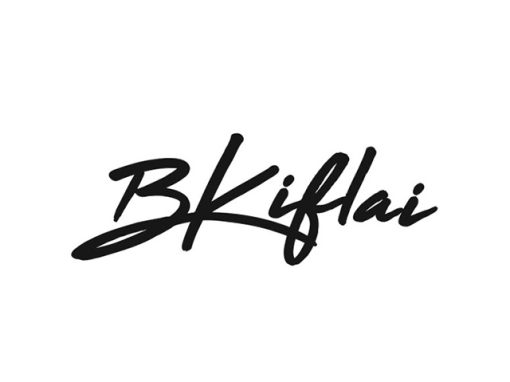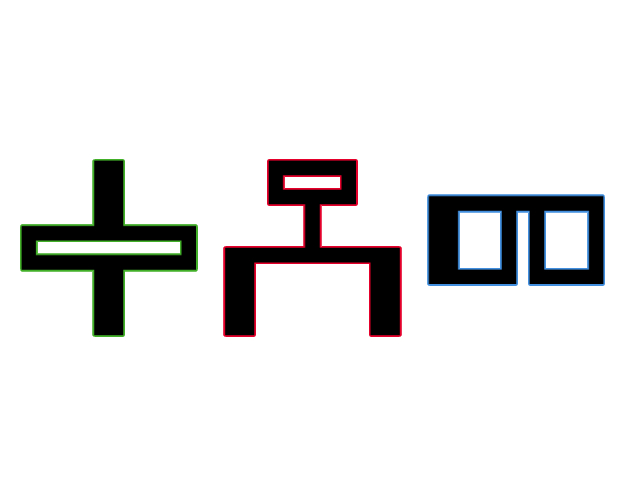
From a-bu-gi-da to alpha-bet
Abugida, sometimes called alphasyllabary, is a segmental writing system coined by Peter T. Daniels in 1990. The title – similar to how abecedary is derived from the first Latin letters “ABCD” as well as alphabet from the first Greek letters alpha and bet – is derived from the first four letters of the Ge’ez system, አ (a), ቡ (bu), ጊ (gi), ዳ (da).


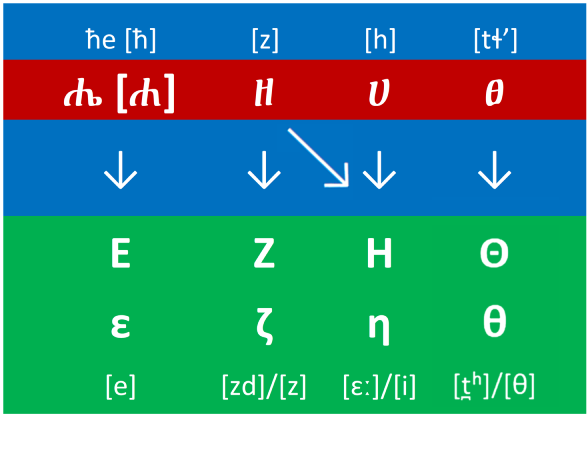
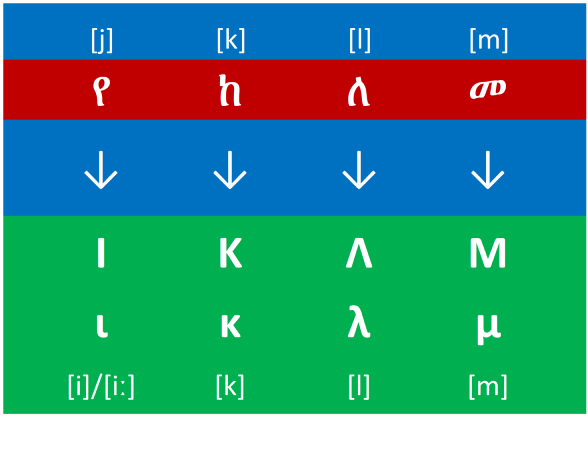
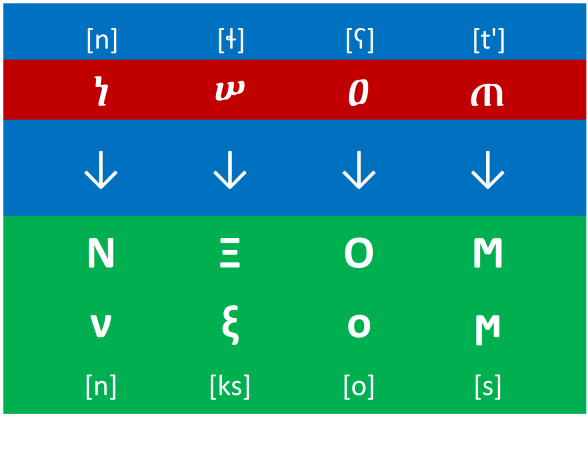


Reviewing the relationship between the two scripts primarily through the scope of a direct relationship…
The Ge’ez abugida syllabary group order is አ (ʾ), በ (b), ገ (g), ደ (d), ሀ (h), ወ (w), ዘ (z), ሐ (ḥ), ጠ (ṭ), የ (y), ከ (k), ለ (l), መ (m), ነ (n), ሰ (s), ዐ (ʿ), ፈ (f), ጸ (ṣ), ቀ (q), ረ (r), ሠ (ś), ተ (t), ኀ (h̬), ፀ (ḍ) [Latin phonetic equivalents in parenthesis]. A PDF of the ancient abugida alphabet is provided here.
አ/ዓ – Α/α (alpha): these characters are in absence of a true consonant, glottal stop. Both “አ” and “Α” are represented in the phonetic value of the American English word “uh.” On the other hand, “ዓ” (which is the 4th form of the “ዐ” syllabary group) and is similar to “α” as in the the American English word “otter” however with the use of the pharynx.
በ, ፈ, ወ – Ππ, Ββ, Ϝϝ, Φφ: I’ve put these characters in the same group due to their visual similarities as well as their history of betacism-esque phonetic variations with one another from one language to another whether within the same language group or otherwise. Though the Ge’ez characters have kept their forms and phonetic values since ancient times, there have been a few changes to their Greek and subsequent Romance counterparts. A full post elsewhere would do this topic justice. For now, there currently is not and is said to have never been a Greek equivalent to “በ (b)” and prior to the Aksumite conversion to Christianity, there was no indigenous “p” sound either. So, due to the visual resemblance with Π/π (pi) and very subtle difference in sound between the characters, it would not be a stretch to hypothesize a common origin or possible correlation between the letters. For the rest of the letters – in summary – it is common, at least in the Indo-European languages that the phonetic values of these letters either have since or already had evolved into another in a natural linguistic process. In lieu of a dedicated page for a deep delve into this, a few examples are: the adoption of the “v” sound from “w” in German and many Romance languages; outside of borrowed words, “v” makes the “f” sound indigenously in German; in Archaic Latin, if “b” in a word came before “s” or “t,” its pronunciation was replaced by “p,” though this rule was inconsistent; in Classical Latin “v” represented a sound similar to “w”; etc.
ሀ, ሐ: both are voiceless glottal fricatives while the latter is pharyngeal. Greek does not have a phoneme for either “h” or “ḥ” sounds. Instead, the characters in these syllabary groups could be associated, at least visually, with the Greek letters that made the remaining vowel sounds (those not visually resembling either alpha or omicron) – Ε/ε (epsilon), η (eta), and Υ/υ (upsilon).
ዘ: though the “z” phonetic value for this character correlates with Ζ/ζ (zeta), it’s interesting that it’s nearly identical to the uppercase form of the Greek eta – “Η“; in other words, the two characters can be described as homoglyphs. In addition, their positions in their respective alphabetical order are the same; they’re both the 7th letter in their respective systems.
ፀ: this is the last syllabary group of Ancient Ge’ez – not to be confused with the final letter of the abugida script. The letter that corresponds to the same position as the Greek counterpart – 9th letter – is ጠ (ṭ). The similar phonetic value for ጠ (ṭ) and ፀ (ḍ) as well as the visual similarity of the supposed homoglyphs (ፀ and θ) leaves room to speculate that these letters either have the same origin or are direct counterparts – differing due to a number of possible reasons including a dialectal variation whether from translation or occurring indigenously over time.
ሠ: the three limbs of this character along with it’s phonetic value representing the likeness of a snake’s hiss, “s,” gives an indication of a possible link with the Greek counterparts Ξ/ξ (xi), Σ (sigma), Ψ/ψ (psi) – all of which involve a hissing sound. [The lower case sigma letters, σ/ς, resemble the two other Ge’ez “hiss” characters – “ሰ” and “ጸ.”]
ዎ [ወ]: Ψ/ψ (omega) is the final letter of the Greek alphabet. Maybe a coincidence but, “ዎ” (wo) which is the 7th and final order of the “ወ” syllabary group is also the last letter of the ancient Ge’ez abugida. It’s also interesting to note that a lot, if not the majority, of the root verbs that contain “ወ” as the second or third character in their spelling produce the phonological process of assimilation – effectively transforming a trilateral into a bilateral. For example, the bilaterals ኮና (from ከወነ) and ሀሎ (from ሀለወ) are root verbs. A separate letter for the Greek alphabet – omega – may have been induced as a result.
A few directly-related words, either borrowed from one another or having a common ancestor…
| Ge'ez | Greek |
| ይሕርስ + ገለፈ (yəḥərəs + gäläfä) "practice sorcery" + engrave/imprint | ιερός (ierós) sacred + γλύφωμα (glýfoma) glyph |
| ክርታስ (krtas) scroll/paper/leaf of paper | καρτούς (kartoús) cartouche |
| ሰበን (seben) napkin/handkerchief/scarf | σάβανον (savanon) shroud |
| አየር ('äyyär) air | αέρας (aéras) air |
| ልጥር (ltr) measure of weight | λίτρο (lítro) liter |
| ረፍአ; መርፍእ (räfʾä; märfʾǝ) sew/needle (instrument for sewing/stitching) | ράπτω/ράβω (rávo/rápto) sew/needle/stitch |
| ሲናፔ (sinape) mustard | σινάπι (sinápi) mustard |
| ሲላን (silan) dill | σέλινο (selino) celery |
| ሰሊጥ; ሰላጣ (säliẗ; säläẗä) sesame [used mainly as salad dressing]; salad | σαλάτα (saláta) salad |
| አውልዕ (äwlʿ) olive tree | ελιά (eliá) olive |
| ሎሚ (lomi) lemon | λεμόνι (lemóni) lemon |
| ሩዝ (ruz) rice | ρύζι (rýzi) rice |
| ሜስ (meis) honey wine | μέθυ (méthy) drunk [honey wine] |
| ምስጢር (mstir) mystery/secret | μυστήριο (mystírio) mystery |
| ጽሌ/ጽላ (ṣəle/ṣəla) tablet of metal or stone / tablet of law [stele] | στήλη (stíli) standing block [stele] |
| ፈላስፋ (fälasfa) philosopher | φιλόσοφος (filósofos) philosopher |
| መየጠ/ሜጠ (mäyätä/metä) transform | μετά (meta) with/after/behind |
| አይቁና (äyquna) icon | εικών (eikón) image/icon |
| በርበራ; በርባሪ (bärbärä; bärbari) pillage/plunder; plunderer | βάρβαρος (várvaros) barbarian |
| ፓና (pana) lamp/torch | Φάνης (Phanes) mythological deity of light |
| ላንጳስ (lanp̣as) lamp/torch | [Tigrinya: ልጨ (ləč̣e) light] | λάμπα (lámpa) lamp | λυχνία (lychnía) lamp |
| ሲኖዶስ (sinodos) synod / ecclesiastical assembly | σύνοδος (sýnodos) synod |
| ጳዝዮን (p̣azyon) topaz | τοπάζι (topázi) topaz |
| መረግድ/ዘመረግድ (märägd/zämärägd) emerald | σμαράγδι (smarágdi) emerald |
| ሐበረ/ሕቡር/ሑቡር (ḥäbärä/ḥbur/ḥubur) [beautify]/colored / of diverse colors | Εβραίος (Evraíos) Hebrew |
| Ge’ez | Greek |
| ይሕርስ + ገለፈ (yəḥərəs + gäläfä) “practice sorcery” + engrave/imprint | ιερός (ierós) sacred + γλύφωμα (glýfoma) glyph |
| ክርታስ (krtas) scroll/paper/leaf of paper | καρτούς (kartoús) cartouche |
| ሰበን (seben) napkin/handkerchief/scarf | σάβανον (savanon) shroud |
| አየር (‘äyyär) air |
αέρας (aéras) air |
| ልጥር (ltr) measure of weight | λίτρο (lítro) liter |
| ረፍአ; መርፍእ (räfʾä; märfʾǝ) sew/needle (instrument for sewing/stitching) | ράπτω/ράβω (rávo/rápto) sew/needle/stitch |
| ሲናፔ (sinape) mustard | σινάπι (sinápi) mustard |
| ሲላን (silan) dill | σέλινο (selino) celery |
| ሰሊጥ; ሰላጣ (säliẗ; säläẗä) sesame [used mainly as salad dressing]; salad | σαλάτα (saláta) salad |
| አውልዕ (äwlʿ) olive tree | ελιά (eliá) olive |
| ሎሚ (lomi) lemon | λεμόνι (lemóni) lemon |
| ሩዝ (ruz) rice | ρύζι (rýzi) rice |
| ሜስ (meis) honey wine | μέθυ (méthy) drunk [honey wine] |
| ምስጢር (mstir) mystery/secret | μυστήριο (mystírio) mystery |
| ጽሌ/ጽላ (ṣəle/ṣəla) tablet of metal or stone / tablet of law [stele] | στήλη (stíli) standing block [stele] |
| ፈላስፋ (fälasfa) philosopher | φιλόσοφος (filósofos) philosopher |
| መየጠ/ሜጠ (mäyätä/metä) transform | μετά (meta) with/after/behind |
| አይቁና (äyquna) icon | εικών (eikón) image/icon |
| በርበራ; በርባሪ (bärbärä; bärbari) pillage/plunder; plunderer | βάρβαρος (várvaros) barbarian |
| ፓና (pana) lamp/torch | Φάνης (Phanes) mythological deity of light |
| ላንጳስ (lanp̣as) lamp/torch | [Tigrinya: ልጨ (ləč̣e) light] |
λάμπα (lámpa) lamp | λυχνία (lychnía) lamp |
| ሲኖዶስ (sinodos) synod / ecclesiastical assembly | σύνοδος (sýnodos) synod |
| ጳዝዮን (p̣azyon) topaz | τοπάζι (topázi) topaz |
| መረግድ/ዘመረግድ (märägd/zämärägd) emerald | σμαράγδι (smarágdi) emerald |
| ሐበረ/ሕቡር/ሑቡር (ḥäbärä/ḥbur/ḥubur) [beautify]/colored / of diverse colors | Εβραίος (Evraíos) Hebrew |
“Greece” is an exonym for the ancient Greeks.
Their land, instead, was called Ελλάδα (Elláda) which, in Ge’ez, translates to እላዴ (ʾəllāde) [the] gathering – [root: አለደ (ällädä)].
It is said that:
- The Greeks based their alphabet on the Phoenician script and that;
- The Ge’ez script evolved from the South Arabian script which itself is a descendant of the same Phoenician script that the Greeks adopted for theirs.
Each Phoenician letter-acrophony combo bares an uncanny resemblance to it’s possible Ge’ez counterpart below:








The above illustrations have a variation from widely accepted transliterations and thus are included in the below footnotes.
- Ge’ez letters do not have names – or at least they were not named indigenously. This is an indication that, for one reason or another, the African Ge’ez speakers were in no need of these direct intimations for the sounds of the letters for which their oral tradition has categorically insisted has been used by them for millennia. Instead, I’ve added words that start with a letter from the associated syllabary group and are most complementary to their Phoenician counterpart acrophonies either by their spelling or by their definitions.
-
ኣፍላ (ʾafla) – this is a Tigrinya word roughly for “preliminary.” The word for “cow” in Ge’ez is አሓ (äḥa).
-
ሀለለ (hälälä) – As it may be related, it’s important to note that the Ancient Egyptian hieroglyph for “hillul,” 𓀠, is a determinative for words relating to joy or happiness. This glyph depicting a man with his hands raised on either side, however, may have been the predecessor for another voiceless fricative as ሐ (ḥ) which has a more truer visual representation along with a comparable definition – ሐለየ (ḥäläyä) sing / celebrate with songs.
- ሥን (śən) virtue – however similar, the proper spelling of “tooth” in Ge’ez is ስን (sn).
-

